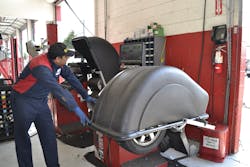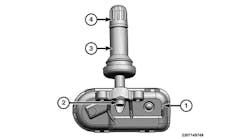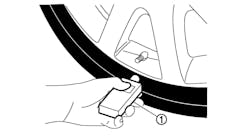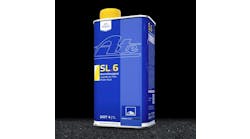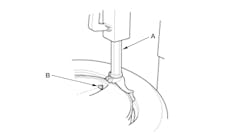Everyday shop equipment can range from a few thousand dollars to tens of thousands of dollars, and no one wants to make a major purchase hastily. A good rule of thumb is to make the necessary repairs or purchase a replacement machine before it becomes critical.
“With 63 stores, one of my biggest fears is to have to buy tire changers for 63 stores at one time,” says Mark Rhodes, president of Plaza Tire Service Inc. in Cape Girardeau, Mo.
When decision time comes, store owners and managers look at major aspects such as the age of the machine, productivity and the cost of repairs versus the cost of buying a new one.
“We also look to see if it’s going to provide an opportunity to generate new revenue or a new revenue stream,” says Jason Frink, equipment sales/distribution for BTS Tire & Wheel Distributors in North and South Carolina. “Is it going to allow you to do things that you can’t currently do? Also, consider market trends and anticipated trends in the market. Technology changes so quickly. Are you going to need to upgrade what you have? How much is that going to cost over the next few years, and what’s the return on investment on the new equipment?”
We reached out to five former Tire Dealers of the Year to give us their tips and suggestions on how to decide whether to repair or replace the main pieces of equipment in your shop. In some cases, they had us talk with the appropriate associate.
Tire changers/wheel balancers
Tire changers and wheel balancers are some of the most used pieces of equipment in a shop, and wear and tear starts to show after a few years of continuous daily use.
“Different shops wear out equipment at different rates because of how much they use them versus other shops,” Rhodes explains. “So the wear and tear in some shops might allow you to keep machines shorter or longer, and some shops are just naturally harder on equipment, especially tire changers and balancers.”
There aren’t many abnormal breakdowns on tire changers or balancers. Rather, small parts are more likely to fail and cause breakdowns.
“On tire machines, it’s just the everyday wear and tear of the pistons moving in and out of the machine,” says Chris Mitsos, vice president of Mountain View Tire & Service Inc., based in Rancho Cucamonga, Calif. “The seals on the pistons tend to go out, so that’s normal wear and tear. The piston that moves the arm in and out, that tends to be what goes first on those.
“The other most common thing we see is the airlines get frayed and come apart. You’ll hear a loud bang in the shop and you’ll hear the air come out. You also see a lot of wear on the turntable where the head slides black and fourth,” adds Frink.To extend the life of tire machines, store owners should perform some regular maintenance and replace small parts as needed.
“You have to keep them clean, you have to make sure the clamps are not worn out, you want to make sure that everything is in tiptop shape,” says Alpio Barbara, owner of Redwood General Tire Service Co. in Redwood, Calif. “A lot of times it’s the small stuff. It might be a special fitting that goes into the airline or a cylinder because you change so many tires.”
Repair or replace? Answer: both. Depending on the brand and model of the equipment as well as the store’s volume, the average life span on changers and balancers is about eight to 12 years. Most older tire changers and balancers are repairable if you really need to get a few more years out of them.
“We’ll take a look at what keeps going wrong and if it’s simple replacing parts and hoses and actuators, inexpensive circuit boards, then we’ll fix it,” Mitsos says. “If the machine in the store is still working good and the guys in the store tell us the machine is still working good, then we’ll tend to fix it if it goes down.”
If you’ve gotten the better part of a decade or longer out of your tire changer or balancer, you’ll likely be ready for an upgrade to accommodate new tires and wheels that roll into your store.
“We deal with so many run-flats, so many high performance, ultra-expensive exotics — everything from Bugatti and McLaren to Mercedes, BMWs and Porches,” says Barry Steinberg, owner of Direct Tire & Auto Service based in Watertown, Mass. “We can’t scratch one of those wheels. The run-flat tires need the best technology and equipment, along with training.”
Additionally, there are some aftermarket add-on features that could allow you to extend the life of a good working balancer.
“There are different plates and flanges that you can add to an existing balancer, especially in the case of these chrome clad wheels,” says Frink. “They’re very difficult to balance using the traditional techniques, so there are add-ons that can help to properly balance them.”
Lifts
If maintained properly, a good lift can easily last more than 15 to 20 years in most shops. However, some owners decide to upgrade before then to take advantage of space-saving capabilities and safety features that are offered on new lifts.
“I had the post lifts that had posts on each side and it made it really difficult to walk around because they’re right next to each other, so we purchased two flush mounts,” Steinberg says. “It’s a Rotary machine and it has no posts. We replaced two previously with Nussbaum scissor lifts. It opens up the floor and gives you more space to work. It’s a safer machine and it’s more user- friendly.”
Some common wear and tear on lifts might include fluid leaking around the cylinders, loose cables and, in the case of two-post lifts, saggy arms. When equipment deterioration starts to put the safety of technicians into question, upgrading is a no-brainer.
“For example, my new lifts, that’s 100% because of safety,” Barbara says.
“When the cables start breaking or getting frayed and they’re not going up correctly, it’s time to replace, which I just did. I replaced all the lifts in my shop a year ago.”
Repair or replace? Answer: replace. Following your lift manufacturer’s proper user guidelines and performing regular maintenance will maximize your lift’s life cycle.
“However, once major components start to fail, it’s time for an upgrade.
“They do have factory recommendations on what to service and when in intervals,” Frink says.
Alignment machines
Alignment racks can last decades, but the technology component needs constant updating.
“Sometimes there are equipment attachments and sometimes its just software,” says Rhodes.
With new car features coming out every year, it’s vital for dealerships to stay on top of the latest updates. “Sometimes they come out with new adapters and new technology that you can add to your alignment machine without replacing everything,” Steinberg explains. “We typically do that to accommodate new cars.”
A lot of new car technology is connected to the vehicle’s steering system and requires calibration once the alignment is completed. “So to properly do that you have to reset steering angle sensors and safety systems and lane departures,” says Frink.
“If you don’t have an alignment machine that is capable of doing that on a modern car, you’re really not performing an alignment, and it does leave you open to some issues.”
Repair or replace? Answer: both. New alignment machines can cost tens of thousands of dollars, and many shops don’t want to drop that kind of dough unless they absolutely have to.
“If we have a machine that goes down and it’s going to cost $4,000 because it needs a whole new computer, new software, a new printer, we’ll look at how old the unit is and what’s the cost difference between getting it new or fixing it,” Mitsos says. “Alignment machines are really expensive, so that would be one of the few times where we would spend $3,000 to $5,000 to have it repaired back to where it needs to be.”
Air compressors
Air compressors require regular maintenance to stay in good operating condition, but otherwise will provide many good years of service without a lot of issues.
“You have to service them, you have to change the oil,” Mitsos says. “If you don’t change the oil you will ruin the compressor, but otherwise they’re like tanks. They last a long time.
“We don’t have too many compressor failures; we don’t see a lot of wear and tear on them. You have to make sure you drain the water out of the lines every day, and you have to change the oil periodically when it’s due.”
Additionally, you may see some belts start to fray or oil leaks around the pump.
Repair or replace? Answer: replace. Air compressors are likely one of the “if it’s not broken don’t fix it” pieces of equipment in the shop. As long as you perform regular maintenance, you shouldn’t have many problems.
When it is time to replace your air compressor, many shop owners are gravitating toward quieter machines to make their shop more comfortable for techs.
“Old compressors make so much noise but we use rotary screw compressors,” Steinberg says. “You can have a conversation standing right next to it. It hardly makes any noise and the guys really appreciate that. They appreciate that their ears aren’t going to get beat up by the noise of the compressor all day long.”
Diagnostic equipment
Scanners need regular software updates if you want to be able to diagnose and repair newer cars. There isn’t much wear and tear or maintenance that goes along with them as long as they’re regularly updated through the manufacturer.
More often than not, you’ll likely replace a scanner because it goes missing.
“Those tend to be the first things that get stolen, either if you have a store break-in or if a disgruntled employee is leaving you,” Mitsos says. “Those tend to ‘grow legs.’ They’re easy to steal because they’re small and easy to conceal. You can’t really walk out with a tire balancer.”
Repair or replace? Answer: replace or repair via software updates.
While some shops are quick to jump on software updates, many times they aren’t readily available because automobile dealers delay the release of repair information on new models.
“If our association would really battle for Right to Repair… we would get the technology a lot sooner than we do now,” Barbara says.
“We have to wait sometimes two or three years for the manufacturer to release it. That’s not fair for the independent tire dealer. We can’t get the information fast enough.”
Other dealers don’t mind waiting a year or two before they acquire new software.
“There’s no need to have updates for 2018 because if a 2018 car comes in with a check engine light, they’re going back to the dealer,” Mitsos says. “If you’re updated for 2016-2017 you’re in good shape. Anything newer than that is under warranty. No one is going to pay to have it repaired when it’s under warranty.”
What to do with old equipment
Another factor in deciding whether to repair a piece of equipment or purchase something new is the question of what you’re going to do with your old piece of equipment.
Many shops can use the old equipment or make a little cash off of it.
“As soon as we have one we know needs to be changed, we remove it and put a new machine in and then we’ll fix or sell or reuse our old machine,” Rhodes says. “I do that pretty aggressively just do avoid having multiple machines to buy at once.”
You also can make a little money back on your old equipment either by using it for a trade-in or selling it yourself.
“When we upgraded our lifts, we went on Craigslist and we sold our two old lifts,” Steinberg says.
“Two local shops called us and they wanted to know the condition and how much they were. For me I got my money’s worth because I had them for about 15 years. And for the smaller shops, they got something they couldn’t afford new, and everyone was happy.”
For dealers with multiple locations, it might make sense to purchase new equipment at one store and move the old machine to another store where it can get additional use.
“When we upgrade equipment in store A, the machine that’s coming out of store A might be better than the machine in store B, so many times we’ll send the machine from store A to store B,” Mitsos explains. “It’s an upgrade for store B even though it’s not new, and then the one in store B gets disposed of.”
A careful decision
Whether repairing a tire machine to get a few more years of work out of it or upgrading a lift that’s been in your shop for nearly 20 years, the decision to invest in your equipment is not one that’s made on a whim.
“We walk a fine line between being proactive with upgrading our equipment and being reactive,” Mitsos says. “The easy thing to do is be reactive and just wait until everything breaks, but we try not to do that.”
No one wants to spend thousands of dollars on repairs only to find out their machine won’t be able to keep up with the latest car technology in five years. On the flip side, some owners don’t want to jump the gun and buy something new if a good working machine just needs a few minor repairs.
“It’s like a car. If it keeps breaking down and if you start to put too many repairs on a piece of equipment, it’s time to replace it,” Barbara says.
The bottom line is that having good working equipment and giving technicians the tools they need to get the job done is essential for your business flow, whether it be a new machine or something that has been in the shop for years.
“You don’t want guys coming to you saying, ‘I scratched a wheel because the breaker bar is bent and I told you that three months ago,’” Steinberg says.
Lastly, while upgraded equipment is nice, you don’t necessarily have to go for a high-end model or even the newest generation of equipment to service your customers.
“Take a look at what makes up your traffic, what makes up your customers,” says Steinberg. “What are they driving? If you can’t work on a BMW 740i because you’ve never had one in your shop, then don’t worry about it. If you have to turn one person away because they drove in with it, then so be it.
“What are 90% of your other cars driving into your store every day? You have to be prepared for those people.” ■
In the know about shop flow
We contacted five former Tire Dealers of the Year to find out how they keep their service bays stocked with the proper equipment. They are:
Barry Steinberg, owner, Direct Tire & Auto Service, Watertown, Mass. (1993)
Nick Mitsos, president, Mountain View Tire & Service Inc., Rancho Cucamonga, Calif. (2011)
Ricky Benton, president, Black’s Tire Service Inc., the parent company to BTS Tire & Wheel Distributors, Whiteville, N.C. (2015)
Alpio Barbara, owner, Redwood General Tire Service Co., which does business as Redwood General Tire Pros in Redwood City, Calif. (2016)
Mark and Scott Rhodes, owners, Plaza Tire Service Inc., Cape Girardeau, Mo. (2017)
Shana O’Malley-Smith is a freelance writer living in northeast Ohio. She specializes in the automotive aftermarket.
